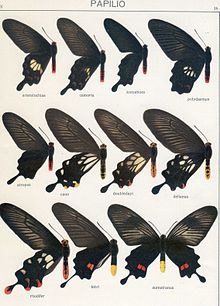Red-bodied swallowtail
| Red-bodied swallowtail | |
|---|---|

| |
| Pachliopta hector | |
| Scientific classification | |
| Domain: | Eukaryota |
| Kingdom: | Animalia |
| Phylum: | Arthropoda |
| Class: | Insecta |
| Order: | Lepidoptera |
| Family: | Papilionidae |
| Subfamily: | Papilioninae |
| Tribe: | Troidini |
| Species | |
|
About 46; see text | |
| Groups included | |
| |
| Synonyms | |
| |
Red-bodied swallowtails, or ruby swallowtail (due to the color), are butterflies in the swallowtail family, that belong to the genera Atrophaneura, Byasa, Losaria, or Pachliopta. They are generally found in Asia (Indomalayan realm).
Collectors have found the red-bodied swallowtails difficult to kill. Pinching the thorax, a method which kills most butterflies, is withstood and only stuns the butterfly temporarily.[citation needed]
Life history
[edit]The larvae resemble those of other Troidini. Fleshy spine-like tubercles, often with red tips, line the caterpillars' backs, and their bodies are dark red to brown and velvety black or shades of grey with a pattern of black lines. They feed on species of Aristolochia and Thottea. Chrysalids are camouflaged to look like a dead leaf or twig. They are attached by a girdle and an anal pad. Adults are nectar feeding.
Many species of red-bodied swallowtails show aposematism,[1] and serve as models for Batesian mimicry. The biology of Pachliopta hector and Pachliopta aristolochiae are well studied.
-
Pachliopta hector egg
-
Pachliopta aristolochiae larva
-
Byasa alcinous pupa
Taxonomy
[edit]Species limits may be either narrow (many species - forma and subspecies raised to full or "good" species) or broad (fewer species - rank reduction) see Jürgen Haffer for a discussion.
Genera and species
[edit]


Listed alphabetically within genera:[2]
genus: Atrophaneura Reakirt, [1865][2] (earlier considered as the nominotypical subgenus of Atrophaneura but now it is a genus without subgenera)[3]
- Atrophaneura aidoneus (Doubleday, 1845) — lesser batwing
- Atrophaneura dixoni (Grose-Smith, 1900)
- Atrophaneura horishana (Matsumura, 1910) — aurora swallowtail
- Atrophaneura kuehni (Honrath, 1886)
- Atrophaneura luchti (Roepke, 1935)
- Atrophaneura nox (Swainson, 1822) — Malayan batwing
- Atrophaneura priapus (Boisduval, 1836) — Priapus batwing
- Atrophaneura semperi (C. & R. Felder, 1861)
- Atrophaneura schadenbergi (Semper, 1891)[4]
- Atrophaneura sycorax (Grose-Smith, 1885)
- Atrophaneura varuna (White, 1842) — common batwing
- Atrophaneura zaleucus (Hewitson, [1865])
genus: Byasa Moore, 1882 (earlier considered as subgenus Byasa but now raised to genus level)[3]
- Byasa adamsoni (Grose-Smith, 1886) — Adamson's rose
- Byasa alcinous (Klug, 1836) — Chinese windmill
- Byasa crassipes (Oberthür, 1893) — black windmill
- Byasa daemonius (Alphéraky, 1895)
- Byasa dasarada (Moore, 1857) — great windmill
- Byasa hedistus (Jordan, 1928)
- Byasa impediens (Rothschild, 1895)
- Byasa laos (Riley & Godfrey, 1921)
- Byasa latreillei (Donovan, 1826) — rose windmill
- Byasa mencius (C. & R. Felder, 1862)
- Byasa nevilli (Wood-Mason, 1882) — Nevill's windmill
- Byasa plutonius (Oberthür, 1876) — Chinese windmill
- Byasa polla (de Nicéville, 1897) — De Niceville's windmill
- Byasa polyeuctes (Doubleday, 1842) — common windmill
- Byasa rhadinus (Jordan, 1928)
genus: Losaria Moore, [1902] (earlier considered as subgenus Losaria but now raised to genus level)[3]
- Losaria coon (Fabricius, 1793) — common clubtail
- Losaria palu (Martin, 1912) — Palu swallowtail - has been regarded a subspecies of A. coon[5]
- Losaria rhodifer (Butler, 1876) — Andaman clubtail
- Losaria neptunus (Guérin-Méneville, 1840) — yellow-bodied club-tail or yellow club-tail
genus: Pachliopta Reakirt, [1865] (earlier considered as subgenus Pachliopta but now raised to genus level)[3]
- Pachliopta adamas (Zinken, 1831)
- Pachliopta aristolochiae (Fabricius, 1775) — common rose
- Pachliopta antiphus (Fabricius, 1793)
- Pachliopta atropos (Staudinger, 1888)
- Pachliopta hector (Linnaeus, 1758) — crimson rose
- Pachliopta jophon (Gray, [1853]) — Ceylon rose or Sri Lankan rose
- Pachliopta kotzebuea (Eschscholtz, 1821) — pink rose
- Pachliopta leytensis (Murayama, 1978)
- Pachliopta liris (Godart, 1819)
- Pachliopta mariae (Semper, 1878)
- Pachliopta oreon (Doherty, 1891)
- Pachliopta pandiyana (Moore, 1881) — Malabar rose
- Pachliopta phlegon (C. & R. Felder, 1864)
- Pachliopta polydorus (Linnaeus, 1763) — red-bodied swallowtail
- Pachliopta polyphontes (Boisduval, 1836)
- Pachliopta strandi (Bryk, 1930)
References
[edit]- ^ Kitching, Roger Laurence (1999). Biology of Australian Butterflies. Csiro Publishing. p. 131. ISBN 978-0-643-05027-3. Retrieved 5 July 2013.
- ^ a b Savela, Markku (16 Feb 2008). "Atrophaneura". Lepidoptera and some other life forms. nic.funet.fi. Retrieved 21 June 2013.
- ^ a b c d Häuser, Christoph L.; de Jong, Rienk; Lamas, Gerardo; Robbins, Robert K.; Smith, Campbell; Vane-Wright, Richard I. (28 July 2005). "Papilionidae – revised GloBIS/GART species checklist (2nd draft)". Entomological Data Information System. Staatliches Museum für Naturkunde Stuttgart, Germany. Retrieved 21 June 2013..
- ^ Gimenez Dixon, M. (1996). "Atrophaneura schadenbergi". IUCN Red List of Threatened Species. 1996: e.T2379A9436065. doi:10.2305/IUCN.UK.1996.RLTS.T2379A9436065.en. Retrieved 10 January 2018.
- ^ Hancook, D.L. (1982). A note on Atrophaneura palu (Martin) 1912. Papilo International. 1(3): 71-73
External links
[edit]- Flickr Correctly identified tagged photos
- Atrophaneura at Butterflycorner.net
- Pteron



